Description 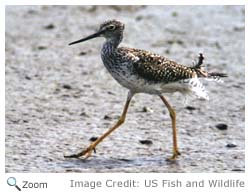 The greater yellowlegs is a medium-sized wading bird that is about 11-14 inches in length. It has very long yellow legs and a long, slightly turned up bill. Its tail is marked with black bars. Its back and wing are a streaked grayish-brown. Its face, neck, chest, and belly are white with brown and gray speckles. The greater yellowlegs is a medium-sized wading bird that is about 11-14 inches in length. It has very long yellow legs and a long, slightly turned up bill. Its tail is marked with black bars. Its back and wing are a streaked grayish-brown. Its face, neck, chest, and belly are white with brown and gray speckles.
Range 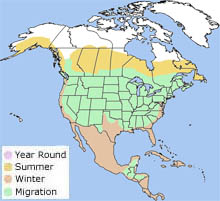 The greater yellowlegs breeds from south-central Alaska east to Newfoundland. It winters on the Pacific coast from Washington south, on the Atlantic coast from Virginia south, and along the Gulf Coast. The greater yellowlegs breeds from south-central Alaska east to Newfoundland. It winters on the Pacific coast from Washington south, on the Atlantic coast from Virginia south, and along the Gulf Coast.
Habitat
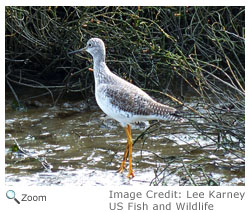 The greater yellowlegs breeds on the tundra and marshy areas. During migration and in the winter, it is found on lakeshores and tidal mudflats. The greater yellowlegs breeds on the tundra and marshy areas. During migration and in the winter, it is found on lakeshores and tidal mudflats.
|
|
Diet 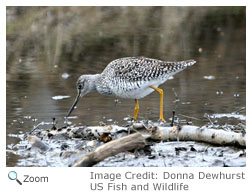 The greater yellowlegs wades through the shallow water with its long legs, sweeps its head back and forth, and skims up small fish and aquatic animals in its turned up bill. It also runs after fish and stabs them with its long, pointed bill. It swallows its prey whole. Sometimes it has to reposition a fish a couple of times before it can swallow it. It feeds during the day and the night. The greater yellowlegs wades through the shallow water with its long legs, sweeps its head back and forth, and skims up small fish and aquatic animals in its turned up bill. It also runs after fish and stabs them with its long, pointed bill. It swallows its prey whole. Sometimes it has to reposition a fish a couple of times before it can swallow it. It feeds during the day and the night.
Life CycleTo attract a mate, the male runs around a female in circles while holding up his wings. The female lays 4 eggs in a depression in the ground on a damp, open spot. The chicks hatch in 23 days and fledge in 18-20 days. Both parents incubate the eggs and feed the chicks.
Behavior
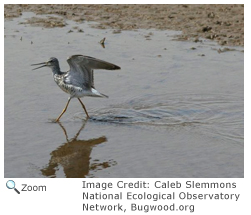 The greater yellowlegs' call is a series of musical whistles. It is a very noisy bird. It often runs in shallow water and bobs its head up and down when it spots a potential predator. It has a high-stepping walk and sometimes runs with its neck stretched out. It also swims on the water from time to time to get to shallow water or to escape from a predator. It is more solitary than most shorebirds, but it does migrate in groups. The greater yellowlegs' call is a series of musical whistles. It is a very noisy bird. It often runs in shallow water and bobs its head up and down when it spots a potential predator. It has a high-stepping walk and sometimes runs with its neck stretched out. It also swims on the water from time to time to get to shallow water or to escape from a predator. It is more solitary than most shorebirds, but it does migrate in groups.
|


 The greater yellowlegs breeds from south-central Alaska east to Newfoundland. It winters on the Pacific coast from Washington south, on the Atlantic coast from Virginia south, and along the Gulf Coast.
The greater yellowlegs breeds from south-central Alaska east to Newfoundland. It winters on the Pacific coast from Washington south, on the Atlantic coast from Virginia south, and along the Gulf Coast.


